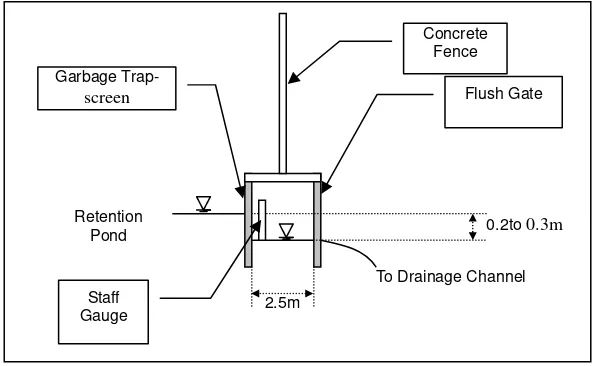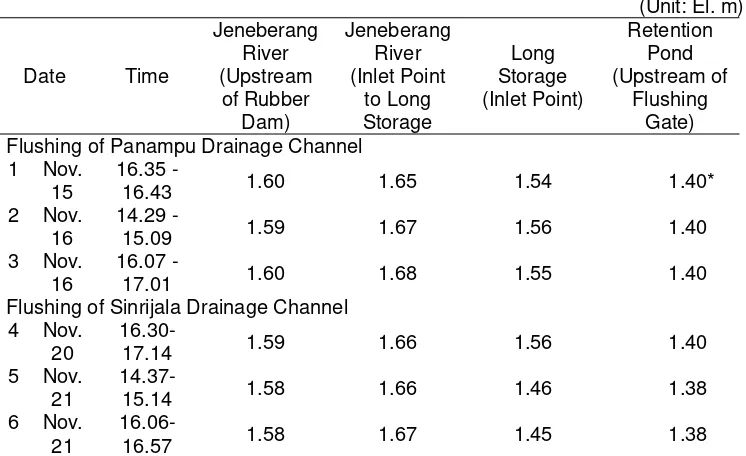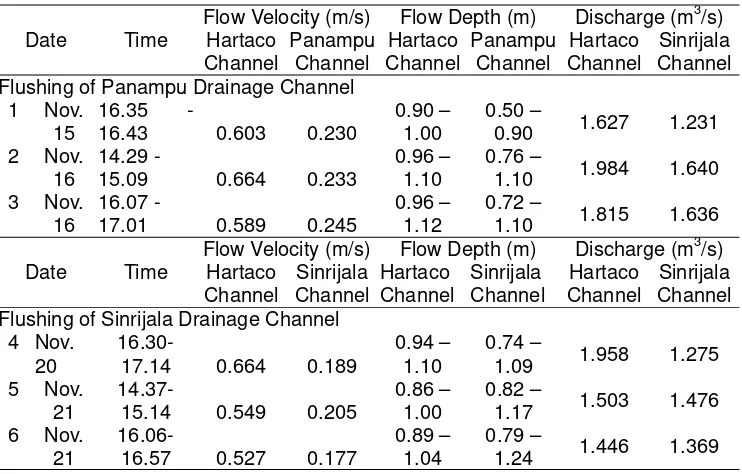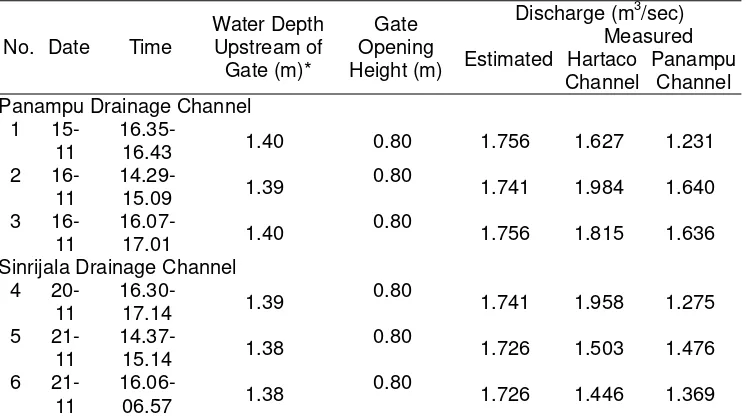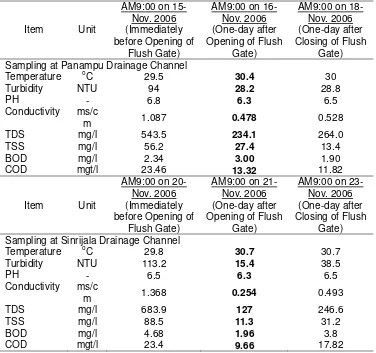West Makassar Main Drainage Flushing Operating Procedure Development
191
WEST MAKASSAR MAIN DRAINAGE FLUSHING OPERATION
PROCEDURE DEVELOPMENT
Melly Lukman*), Mukhlis Ahmad**)
ABSTRAK
Sistem drainase utama yang mencakup hampir seluruh bagian barat dari kota lama Makassar, yang terhubungkan dengan sungai Jeneberang melalui waduk pantai dengan kapasitas 5 m3/detik - 30 m3/detik. Pada beberapa bagian dari sistem ini menumpuk kotoran dan sedimen. Tulisan ini mencoba untuk mengembangkan sistim pengoperasian yang akan menjadi acuan untuk penggelontoran dalam upaya memperbaiki kondisi lingkungan. Metode penggelontoran dilakukan sebagai berikut : 1) Persiapan 2) Pengambilan contoh air sebelum pintu penggelontor dibuka, pintu kontrol ditutup 3) Penggelontoran selama 24 sampai 28 jam 4) Pengambilan contoh air saat setelah 24 jam - 28 jam penggelontoran, kemudian pintu penggelontor ditutup 5) Sistem drainase berjalan seperti biasa selama 24 sampai 48 jam 6) pengambilan contoh air 7) Test contoh air 8) Evaluasi kualitas air. Penggelontoran dilakukan sselama 3 hari untuk keseluruhan sistem drainase,; Jongaya, Sinrijala dan Panampu, serta tes laboratorium untuk sample air yang diambil sebelum dan sesudah penggelontoran. Kualitas air di akhir hari pertama penggelontoran menunjukkan perubahan yang signifikan. Akan tetapi sehari setelah penggelontoran berakhir, kualitas air menunjukkan cepatnya kembali ke kondisi awal. Berdasarkan sistem penggelontoran dan test laboratorium dan evaluasi yang dilakukan, maka direkomendasikan sistim penggelontoran sebagai berikut : 1) Penggelontoran harus dilakukan secara menerus selama 2 hari untuk setiap operasi penggelontoran 2) Penggelontoran perlu dilakukan setiap 2 minggu sekali selama musim panas 3) Exercise ini harus dilakukan selama musim panas untuk dapat diperoleh sutu prosedure permanen sistim penggelontoran.
Kata Kunci : Penggelontoran, Sistim Pengoperasian, Sistem Drainase, Dampak
Lingkungan
*)
Engineering Faculty of Paulus Christian University of Indonesia Makassar Telp : 081 242 76145, [email protected]
**)
Deputy Head of Dinas PSDA South Sulawesi INTRODUCTION
For many years Makassar has experienced flood problems. One of the most devastating floods occurred on January 13, 1986. the flood water
covered most of the west and eastern parts of the city and has caused a huge damage to the city infrastructures, public facilities, as well as on the resident areas.. Jongaya, Panampu and Sinrijala drainage channels (see Figure1) were TEKNIK
constructed in 1993. Total length of the channels (Jongaya-Panampu-Sinrijala is about 13,870 km, with inspection roads of about 13,870 km, drainage culverts (34 box units, 291 pipe units), control gates (4 units), and fence (14,995 km).
In the course of its existence, city government has not paid serious attention to the urban drainage channels (Jongaya, Panampu and Sinrijala), particularly for control of garbage dumping into the channels. Therefore, water turned out to be blackish in dry season, the smell was reeking and offensive to surrounding area. In addition, many citizens at slum areas were using groundwater from shallow well for shower (not for drinking water) along the drainage channels.
In order to reduce smell and to dilute the water of the channels, test operation of flush gate was carried out. Test operation for Jongaya drainage channel was held in July 2006. Since SNVT Pengendalian Banjir dan Pengamanan Pantai Sulawesi Selatan (South Sulawesi Flood Control and Coastal Protection Project) has dredging works at Panampu drainage channel in 2006, test operation could not be held in July 2006 concurrently with the test operation of Jongaya drainage channel. The test operation for Panampu and Sinrijala just can be held in November 2006.
MAKASSAR MAIN DRAINAGE SYSTEM AND OTHER FACILITIES (FIGURE 1 AND FIGURE 2)
Rubber Dam
Rubber Dam is made of the inflatable
is located 3.65 km upstream from the river mouth playing a role to prevent salinity water from intruding to Lower Jeneberang River and its adjacent Long Storage.
According to the original operation rule, the Rubber Dam is to be fully inflated maintaining its maximum dam crest level of EL. 1.8m during a dry season in order to shut the river flow toward the river mouth and to let the whole river flow into the Long Storage. However, when the test operation was made in this dry season, the Dam was slightly deflated maintaining the dam crest level of EL. 1.70m and allowed the dam overflow toward the river mouth. It was understood that the overflow was required to cool the dam body of rubber in accordance with instruction from the supplier of the Rubber Dam.
Long Storage
Long Storage is a water-storage channel of 5.26 km in length and 150m in width, which is connected to the right bank of the main channel of Jeneberang River about 350m upstream from Rubber Dam. Long Storage has an effective storage capacity of 1.6 million m3 to store the fresh water diverted from Jeneberang River. The water stored in Long Storage is used as water supply source for municipal demand, water source to dilute the water in the three drainage channels, namely Jongaya, Panampu and Sinrijala and, amenity space.
West Makassar Main Drainage Flushing Operating Procedure Development
193 allows opening the Flush Gate, when
the water level of Long Storage is between El. 1.00m (LWL) and El. 1.8m (NHWL). In accordance with the operation rule, the water level of Long Storage was maintained at EL. 1,58 - 1.6m during the 2-day period of test operation through the following operations for the inlet and outlet gates: (a) The Tidal Gate was closed and the
Inlet Gate fully opened in order to keep the higher water level of Long Storage.
(b) The Flush Gate opened with gate opening height of 0.80m for two consecutive days.
Flush Gate
Flush Gate is composed of 2 units of the steel slide gate, which is to be manually lifted ( Figure. 1). The gate is connected to Hartaco Drainage Channel, which is further connected to 3 main drainage channels, namely Jongaya, Panampu and Sinrijala in Makassar City
Drainage Control Gate
Each of three drainage channels is equipped with drainage control gates .These drainage control gates aim at
controlling the flow of drainage channels so as to maximize effects of dilution of the water in drainage channels. All of the drainage control gates are the steel slide gate type, which is to be manually lifted.
During the test operation of Panampu Drainage Channel, the Jongaya and Sinrijala Control Gates were closed and the other way if the test operation is made for Sinrijala Drainage Channel, Jongaya Control Gate is closed and Panampu Control Gate is opened. Under such conditions, the Panampu and Sinrijala Control Gates were opened during the test operation to confirm the effects of the discharge released from Flush Gate for diluting of Panampu and Sinrijala Drainage Channels. The Panampu and Sinrijala Drainage Channel have four and three gate leaves, respectively. The Jongaya and Sinrijala Control Gates were closed, and the Panampu Control Gate was fully opened during the test operation so as to confirm the maximum effects of dilution. During closing of the Jongaya and Sinrijala Control Gates, the water is overflowed
Panampu Drainage Channel
Sinrijala Drainage Channel
Control
Jongaya Drainage Chennel
West Makassar Main Drainage Flushing Operating Procedure Development
195 Fig. 2 Flush Gate Structure
PROFILE OF GATE A-A
DOWNSTREAM GATE A
UPSTREAM GATE A
A A
A SKETCH OF FLUSH GATE
METHODOLOGY
Clarification on hydraulic conditions of the relevant facilities including measurement of the outflow discharge from Flush Gates, and
measurement of the channel flow discharge and velocity of Panampu and Sinrijala,
and after releasing discharge from Flush Gate;
Color and smell of water of Panampu and Sinrijala drainage channels before and after releasing discharge from Flush Gate, and
Issues on operation manual system development
The test operation procedures are as follows :
Table 1. Test Operation Procedur
Prepatory - Reconnaissance of drainage channel and gates
- Closing of Flush Gate/Drainage Control Gates
Test Operation of Panampu Drainage
Channel
- 1st Water quality sampling at Panampu Drainage Channel before opening age Observation of water levels at the upstream of Rubber Dam (+1.60 m), the inlet of Long Storage (+1.54 m) and the inlet of Flush Gate (+1.40 m)
- Opening of Flush Gate and Panampu Control Gate
- 1st Measurement of outflow discharge from Flush Gate (Hartaco channel), - Q = 1.627 m3/s and flow discharge of Panampu drainage channel ,Q = 1,231 m3/s
- 2nd Water Sampling at Panampu Drainage Channel
- Observation of water levels at the upstream of Rubber dam (+1.60 m), the inlet of Long Storage (+1.55 m) and the of Flush Gate (+1.40 m)
- 2nd Measurement of outflow discharge from Flush Gate (Hartaco channel)
- Q = 1.984 m3/s and outflow discharge of Panampu Drainage Channel , Q = 1.640 m3/s
- Observation of water levels at the upstream of Rubber dam (+1.60 m), the inlet of Long Storage (+1.55 m) and the inlet of Flush Gate (+1.40 m)
- 3rd Measurement of outflow discharge from Flush Gate (Hartaco channel), Q= 1.815 m3/s and outflow discharge of Panampu Drainage Channel , Q = 1.636 m3/s
- Closing of Flush Gate and Panampu Control Gate
- 3rd Water Sampling at Panampu Drainage Channel , one day after closing of Flush Gate
Test Operation of Sinrijala Drainage
Channel
- 1st Water Sampling at Sinrijala Drainage Channell , before opening of Flush Gate
- Observation of water levels at the upstream of Rubber dam (+ 1.59 m), the inlet of Long Storage (+1.56 m) and the inlet of Flush Gate (+1.40 m)
- Opening of Flush Gate and Sinrijala Control Gate
West Makassar Main Drainage Flushing Operating Procedure Development
197
- 2nd Water Sampling at Sinrijala Drainage Channel (AM 09:00), one day after opening of Flush Gate
- Observation of water levels at the upstream of Rubber dam (+1.58 m, the inlet of Long Storage (+1.46 m) and the inlet of Flush Gate (+1.38 m)
- 2nd Measurement of outflow discharge from Flush Gate (Hartaco channel), Q = 1.503 m3/s and outflow discharge of Sinrijala Drainage Channel, Q = 1.476 m3/s
- Observation of water levels at the upstream of Rubber dam (+1.58 m, the inlet of Long Storage (+1.45 m) and the inlet of Flush Gate (+1.38 m)
- 3rd Measurement of outflow discharge from Flush Gate (Hartaco channel) Q = 1.446 m3/s and outflow discharge of Sinrijala Drainage Channel , Q = 1.389 m3/s
- Closing of Flush Gate and Sinrijala Control Gate
Data Processing of Discharge Measurement
- Data Processing and Discussion
- 3rd Water Sampling at Sinrijala Drainage Channel ,one day after closing of flush gate
- Opening of Flush Gate and Drainage Control Gates
- Data Processing and Discussion
- Opening of Jongaya Control Gate
RESULT AND DISCUSSION
Measurement of Water Level
There is a small retention pond for the Flush Gate, and a trash-trap screen is
installed at the outlet of the retention pond or 2.5m upstream of the Flush Gate. The staff gauge is also installed between the screen and the Flush Gate as illustrated in Figure 3.
Garbage
Trap-screen Flush Gate
Retention Pond
To Drainage Channel
2.5m
0.2to 0.3m
Staff Gauge
Concrete Fence
The water for dilution of the drainage channel has the following route: (1)
Jeneberang River Æ (2) Long
Storage/Retention Pond Æ (3) Trash Rack Æ (4) Flush Gate Æ (5) Drainage Channel. In order to know the flow condition, the staff gauge is installed at the following 4 sites:
(1) Jeneberang River just upstream of Rubber Dam,
(2) Jeneberang River at Inlet Gate for Long Storage,
(3) Long Storage at Inlet Gate from Jeneberang, and
(4) Retention Pond just upstream of Flush Gate.
The water levels on the above staff gauges were read before discharge measurement of outflow discharge from Flush Gate. The results of reading are as shown in Table 2.
A substantial volume of garbage has been accumulated at the trash rack impeding the smooth inflow from the Long Storage/Retention Pond to Flush Gate. As the results, a gap of 0.2 to 0.3 m was detected between the water level of Long Storage at Inlet Point and the Retention Pond just upstream of Flush Gate, when the Flush Gate is opened releasing the discharge as listed above.
Table 2 Results of Reading of Water Level on Staff Gauge
(Unit: El. m) (Inlet Point
to Long (Upstream of
Flushing Gate) Flushing of Panampu Drainage Channel
1 Nov.
Flushing of Sinrijala Drainage Channel 4 Nov.
*: The first water level of retention pond was read just before opening of the Flush Gate, while the second, third, and forth and other water levels are during opening of Flush Gates.
West Makassar Main Drainage Flushing Operating Procedure Development
199 Measurement of Flow Velocity and
Discharge
The measurement of flow velocity and discharge was made in Hartaco Drainage Channel just downstream of Flush Gate (± 40m) and in Panampu and Sinrijala Drainage Channels at 60 m upstream from the Drainage Control Gate. The results of measurements are as shown in Table 3.
The above measured flow discharge could be almost equal to the discharge released from the Flush Gate, and could be also estimated from the following formula:
G : Gravitational acceleration (=9.8 m/s)
h0 : Water depth upstream of the gate
C : Coefficient (=0.32)
The discharges are calculated by the above formula based on the observed gate water depth at the upstream point of the gate and then compared with the above-observed values. The results of comparison are as shown in Table 4.
Table 3. Results of Measurements of Flow Velocity and Discharge
Date Time
Flow Velocity (m/s) Flow Depth (m) Discharge (m3/s) Hartaco Flushing of Panampu Drainage Channel
1 Nov.
Flow Velocity (m/s) Flow Depth (m) Discharge (m3/s) Hartaco Flushing of Sinrijala Drainage Channel
4 Nov. 20
16.30-17.14 0.664 0.189 0.94 –
15.14 0.549 0.205 0.86 –
16.57 0.527 0.177 0.89 –
1.04
0.79 –
Table 4. Comparison of Estimated and Measured Discharge
No. Date Time
Water Depth Upstream of Gate (m)* Panampu Drainage Channel
1
15-1.741 1.984 1.640
3 16-11
16.07-17.01 1.40
0.80
1.756 1.815 1.636
Sinrijala Drainage Channel 4
20-11
16.30-17.14 1.39
0.80
1.741 1.958 1.275
5 21-11
14.37-15.14 1.38
0.80
1.726 1.503 1.476
6 21-11
16.06-06.57 1.38
0.80
1.726 1.446 1.369
*: Water Depth = {Water level of Retention Pond read from the staff gauge as listed in Table 2} – {Elevation of the bottom of the gauge (= EL. 0.2m)}
As listed above, the estimated values could accord to the values actually measured in Hartaco Channel, and therefore, the discharge released from the Flush Gate would be substantially estimated from the above formula, when only the water depth upstream of the Gate is read.
A particular attention should be, however, given to the inconsistency between the discharges measured in Hartaco and Panampu Channels in No.1 - No.3 and No.5 to No. 6 of test operation as listed in Table 4. In the No.1, 2 and 3 (Panampu Channel), No.4, 5, and 6 of test operation, the discharge measured in Hartaco Channel is far higher than that in Panampu and Sinrijala Channels.
This inconsistency would be attributed to water losses (it is assumed due to
channel storage, lateral seepage/influent, overflowed water at Jongaya, Panampu and Sinrijala Control Gates were being closed).
Results of Water Quality Test
West Makassar Main Drainage Flushing Operating Procedure Development
201 Table 5.Results of Water Quality Test of Panampu and Sinrijala DrainageChannels
before and after Opening of Flush gate
Item Unit
AM9:00 on 15-Nov. 2006 (Immediately before Opening of
Flush Gate)
AM9:00 on 16-Nov. 2006 (One-day after Opening of Flush
Gate)
AM9:00 on 18-Nov. 2006 (One-day after Closing of Flush
Gate) Sampling at Panampu Drainage Channel
Temperature oC 29.5 30.4 30
AM9:00 on 20-Nov. 2006 (Immediately before Opening of
Flush Gate)
AM9:00 on 21-Nov. 2006 (One-day after Opening of Flush
Gate)
AM9:00 on 23-Nov. 2006 (One-day after Closing of Flush
Gate) Sampling at Sinrijala Drainage Channel
Temperature oC 29.8 30.7 30.7
Results of Field Observation
The following improvements of Panampu and Sinrijala Drainage Channels by releasing discharge of 1.63-1.98 m3/s (at Panampu) and 1.45-1.96 m3/s from the Flush gates were confirmed through the field observation.
The discharge of 2.0 m3
/s is deemed to be the allowable
maximum discharge released from flush gate. Should the Flush Gate release the discharge more than 2.0 m3/s, there would be a danger to cause the overflow in Hartaco Channel.
However, the water quality one day after closing of the gate would return to be almost same as that before releasing of discharge from the gate The offensive odor from Panampu
and Sinrijala Drainage Channels was much reduced after one-day releasing of discharge.
The color of the water in Panampu and Sinrijala Drainage Channels was black before commencement of releasing discharge from Flush Gate. On the other hand, the color changed from black to green after one-day releasing of discharge of about 2.0m3/s from Flush Gate The improvements in smell and
color of water in Panampu and Sinrijala Drainage Channels by two-day releasing of discharge is nil as compared with that by one-day releasing of discharge
A large number of solid wastes still remain in the drainage channel even after two-day consecutive releasing of discharge.
CONCLUSION AND RECOMMENDATIONS
The conclusion from the test operation are as follows ;
The contamination of water in Jongaya, Panampu and Sinrijala Drainage Channels is judged to be out of tolerable level, and certain countermeasures against it should be practiced
The Flush Gate is now usually closed (it is opened only once a year only in August), and the Tidal Gate instead of the Flush Gate is usually kept open during a dry season. Such gate operation aims
Indonesian toward the downstream of Long Storage by the current from the inlet gate to Tidal Gate.
As stated above, the drainage channels are seldom diluted by releasing discharge from the Flush Gates. Nevertheless, a certain effect in diluting the water of Panampu and Sinrijala Drainage Channels is confirmed through the test operation, and therefore, the Flush Gate should be opened more frequently on the premises of the following conditions:
a. The Flush Gate should be
opened once for two days for cleaning of Panampu and Sinrijala Drainage Channels, and should continue to release the discharge for one day. During the time of cleaning of Panampu and Sinrijala Drainage Channels, the control gates of Jongaya Channel should be closed and closing of Panampu and Sinrijala control gates were made by turn.
b. The discharge released from the Flush Gate should be about
2m3/s. The adjustment of
discharge should be made based on the formula described in the above Sub-section 6.2, and the gate opening height estimated from reading of staff gauge in the Retention Pond.
West Makassar Main Drainage Flushing Operating Procedure Development
203 The solid wastes in the drainage
channel are hardly removed by discharge released from the Flush Gates. Accordingly, removal of the solid wastes should be made by the alternative methods such as periodical channel dredging works and installation of trash rack across the drainage channel together with periodical removal of the trash accumulated at the screen.
Recommendation ;
The flushing discharge should be maintained constant at the sama or above the drainage sedigned capacity
Flushing should be performed continuesly for 2 days for each flushing operation
Flushing operation should be conducted every 2 weeks during dry season
This procedure should be exercised during dry season in order to develop a permanent procedure for routine flushing
Bed load should be excavated to meet maximum drain capacity Socialization for public awareness Testing of well water (ground water)
quality
REFERENCES
1. JICA (Japan International
Cooperation Agency), November 2006, Studi Pengembangan Kapasitas Pengelolaan Sungai Jeneberang di Republik Indonesia
2. Chow, Ven Te, “Open Channel
Hydraulics”, International Students Edition, McGraw-Hill, Kogakusha, Ltd, 1979
3. Gupta Ram,S,cs, Hydrology and Hydraulic Systems, 2nd Edition,Waveland Press,Inc, 2001
4. Ray K,Linsley, cs.,. Water Resource Engineering ,3rd Edition, McGraw Hill, Inc,1979
5. Undang-undang No, 23 Tahun 1997 tentang Ketentuan-ketentuan Pokok Pengelolaan Lingkungan Hidup
6. Peratutan Pemerintah No, 27 Tahun 1999 tentang Analisis Mengenai Dampak Lingkungan
